Hiking in Teddy Roosevelt's Footsteps in Yosemite
By Chris Epting
In a turning point for nature preservation and national parks in the USA, President Teddy Roosevelt goes camping with John Muir in the grandeur of the American West.
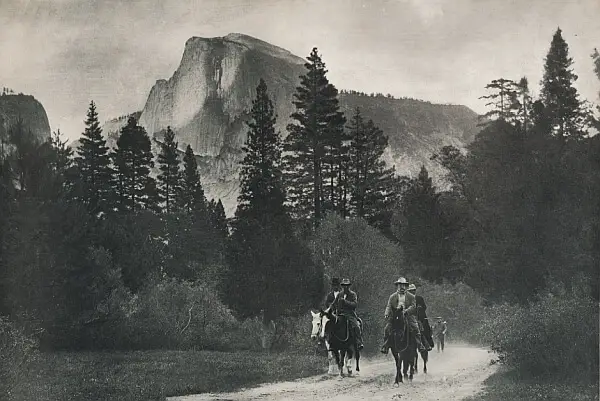
In 1903, two years after becoming the nation's youngest president (age 42) after the assassination of William McKinley, Theodore Roosevelt embarked on his first trip of the western USA to not just help shore up votes for the following year's election, but also to explore and get lost in nature.
His April-June 1903 tour of the west remains one of the most important Presidential sojourns in history. The centerpiece of the trip was Roosevelt's first visit to California, where he would spend nearly three weeks.
Squeezed in between the appearances and pageantry was a historic three-day wilderness adventure at Yosemite with naturalist John Muir. That brief camping trip in Yosemite proved to be a game changer for the wide-eyed President who loved the rugged great outdoors and would soon, thanks to Muir, work even harder to protect it.
The President had followed Muir closely and over time Roosevelt became increasingly interested in discussing his own attitudes toward conservation with Muir face to face. Through California Senator Chester Rowell he communicated to Muir an interest in meeting with him in Yosemite and away from the main party of dignitaries.
March 14, 1903, the following letter was sent to then-famed naturalist, from the White House:
My dear Mr. Muir:
Through the courtesy of President Wheeler I have already been in communication with you, but I wish to write you personally to express the hope that you will be able to take me through the Yosemite. I do not want anyone with me but you, and I want to drop politics absolutely for four days and just be out in the open with you. John Burroughs is probably going through the Yellowstone Park with me, and I want to go with you through the Yosemite.
Sincerely yours,
Theodore Roosevelt
Thirteen days later (in the age before fast cars and airplanes), Muir responded "…of course I shall go with you gladly."
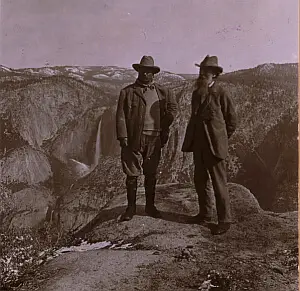
Setting Off in Search of Legends
I was in the middle of writing a book covering Roosevelt's time in California in the spring of 1903. There was to be a heavy emphasis on the camping trip with Muir and so of course I decided to go up to Yosemite and retrace as much of the trip as I could.
The morning of May 15, the men first met on Roosevelt's train in the small town of Raymond, California.
Along with my intrepid 18-year-old daughter, we began our journey in that small town, a one-time gateway to Yosemite. Little remains from back in 1903. The train station where Roosevelt pulled up is gone as is the hotel where he delivered an impromptu speech. But a small piece of track is preserved on the original right-of-way. Might that have been the very spot where Muir wandered into the president's cabin after an overnight journey on the train from Oakland to pay his first greeting?
Following the original stagecoach route, now a paved but well-worn, bumpy and winding road that leads to Yosemite, it's hard to imagine what the distance must been like being pulled by a team of horses. But that is how Roosevelt arrived at Yosemite.
It took the better part of the day to reach the Wawona Hotel, and no doubt Roosevelt was anxious to get out and mount his own horse.

After a lunch stop at the Wawona Hotel, the party proceeded directly to the Mariposa Grove of big trees. Here, following some preliminaries such as picture taking at the Grizzly Giant and Wawona tunnel tree, the president dismissed the troops thanking them for their services. The stage departed with all members of the president's party except Mr. Roosevelt, John Muir, guide Charlie Leidig, Archie Leonard, and an Army packer named Jacher Alder.
This is where were Roosevelt and Muir pitched camp for their first night in the woods. They ate fried chicken and beefsteak over the fire, talking about the woods under the Grizzly Giant tree.
As Roosevelt would later recount: "The first night was clear, and we lay down in the darkening aisles of the great Sequoia grove. The majestic trunks, beautiful in color and in symmetry, rose round us like the pillars of a mightier cathedral than ever was conceived even by the fervor of the Middle Ages. Hermit thrushes sang beautifully in the evening, and again, with a burst of wonderful music, at dawn."
Walking through these woods today along the soft path, it is easy to conjure up what the simple, primitive camp must have looked like, along with the smell of the coffee and the hissing steaks on the fire. A two-mile trail leads past a variety of the famous, cinnamon colored giant trees, including the Grizzly Giant, right by where the group slept. The Wawona tunnel tree, which Roosevelt was driven through, fell to the ground in 1969 but still remains in place.
A snowstorm? "Bully!"
The San Francisco Chronicle reported: The president camped in the Mariposa Big Tree Grove last night. He and Mr. Muir were up at dawn this morning. They came tearing down Lightning Trail, one of the steepest trails in the mountains and passed the hotel at an early hour on a fast gallop. The president looked very buoyant as he rode by, but did not look to the right and left. Only a few people were up early enough to see them go by.
And then it was on to Glacier Point, where the dusty roads all ended. Another dramatic report from the Chronicle documented, Instead of the shelter of the great spreading trees, the warm sunshine and the singing birds, the president now rode through the deep snow, accompanied by John Muir and guides Leonard and Leidig, stopping now and then to allow their fatigued horses to rest before plunging through another snowdrift. Tonight the president and his faithful guides will sleep in the wilderness listening to the sigh of the pine boughs as they swing in the night breezes that blow over the heights of Glacier and Signal peaks, 7000 feet above sea level. Should the storm increase in violence tonight the president and his escort will make their way to the Glacier Point hotel, located some 3 miles away.
They not only survived the snowstorm. They reveled in it. Again, over dinner the men continued to bond and talk about preservation. Muir chided Roosevelt for his habit of sport hunting. It is said this admonishment made the president end that sort of behavior.


A hike or a drive to Glacier Point allows one to marvel at the same views the men enjoyed upon awakening after night two of their camping trip, near the area today known as Roosevelt Point, overlooking the Yosemite Valley. I discovered that an image taken of Roosevelt that morning (along with the famous shots of he and Muir posing together) that's always identified as being shot at Glacier Point, was actually taken at Washburn Point, about a mile away.
Standing in the place where Roosevelt and Muir shared the dawn and posed on Hanging Rock, one could almost imagine Roosevelt's cry of "Bully!" as he awoke to the blanket of snow, sleeping in the wild without a tent.
"We were in a snowstorm last night and it was just what I wanted," he said later in the day. "Just think of where I was last night. Up there," pointing toward Glacier Point, "amid the pines and silver firs, in the Sierran solitude in a snowstorm. I passed one of the most pleasant nights of my life. It was so reviving to be so close to nature in this magnificent forest…"
Heading down to the valley where their third night was spent, a sign marks the site of the campground near Bridalveil Fall. It's the only "official" marker that acknowledges where the men camped, which allows a visitor to actually sit and meditate in the precise spot where Roosevelt and Muir continued to bond.
Then there is the Wawona Hotel, where Roosevelt and Muir both began and ended their Yosemite Valley experience. The peaceful establishment, a complex of old structures, dates back to the 1880s and while Roosevelt didn't sleep here, he did eat lunch here (with Muir) and give a speech just before heading back to Raymond to re-board his train and continue his trip.

The Mystery of the Painting
Also on the Wawona Hotel property is the former studio of the famed artist, Thomas Hill, whose paintings of Yosemite Valley and its environs are some of the most cherished from that period.
I was aware that today, Thomas Hill's 1884 studio had been converted into visitor Center the National Park Service. And also that Roosevelt had actually visited Hill at the end of his visit to Yosemite. As one of the rangers explained to me, Roosevelt was a fan of Hills and was asked to meet him. After excitedly greeting the artist, Roosevelt explained with typical enthusiasm what his previous night had been like at Bridalveil Fall. Noticing a large painting on the wall of the site near the meadow where he and Muir and camped, the president became even more effusive about his feelings for the majestic valley. The Ranger then told me that Hill wasted no time in offering the president the painting, much to Roosevelt's delight. She said it was taken down off the wall and given to Roosevelt right there and that aids would have packed it for the stagecoach ride back to the train, adding it to Roosevelt's growing collection of souvenirs from the trip.
She showed me a photo of the painting and it was indeed beautiful, depicting the meadow area around Bridalveil fall with a small man in the foreground, which gave a sense of perspective to the work of art.
A National Park Service brochure at the site confirmed: "During this visit, Roosevelt met Thomas Hill at his studio. Hill gave Roosevelt a painting of Bridalveil Fall that he had admired, and it returned with him to the White House."
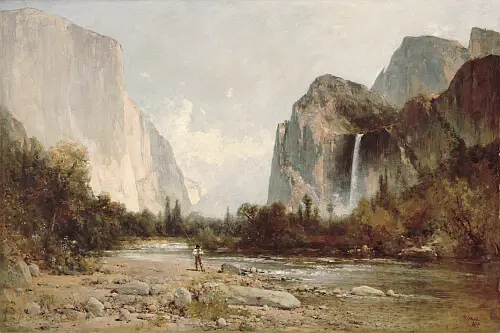
Standing in the visitor Center today I felt a rush of emotion, trying to imagine the looks on these men's faces as this exchange took place. Hill, an artist in residence in the woods being visited by the powerful head of state and gifting him one of his masterworks.
Just after this, the president joined the other members of the official party for the cannonball stage to return to the waiting special train at Raymond. The trip was important in itself because driver Tom Gordon set a record for speed that was never equaled in the 40 years of horse-drawn vehicles. In just 10 hours of actual driving time the party covered the 67 miles from Yosemite Valley to Raymond. The total elapsed time was just short of 12 hours. When he arrived at Raymond, reporters asked him about the Yosemite adventure with Muir. The president told them he had thoroughly enjoyed it. "It was bully," he said. "I had the time of my life!"
Don't Believe Everything the Tour Guides Tell You
When we returned home, I wanted to dig a little bit more to see if there'd been any further communication between Roosevelt and Hill. Indeed, in a letter dated July 6 1903, a couple of months after Roosevelt returned to Washington, he had sent the artist a thank you note.
My dear Mr. Hill:
I thank you very much for your kindness and appreciate you are having sent me the picture. I am glad you have devoted yourself to the assembly work. Surely nowhere is there greater chance for artists who love nature. With renewed thanks, sincerely yours
Theodore Roosevelt
Wait.
Roosevelt said, "having sent me the picture." Sent? This conflicted with the idea of the president's team taking the picture back with them from their visit.
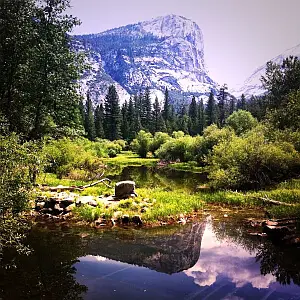
So I dug deeper into the story and found, buried in the May 19, 1903 edition of the long-gone San Francisco Call newspaper, this single reporter's note: "Mr. Hill proposed to paint the president in the foreground, just where he camped, and then send the canvas to Washington."
I went back and looked at the painting closer. Using a higher-resolution image I obtained from the online White House archive, I enlarged the portion that includes the small figure in the foreground. While not the most faithful image of such an iconic figure as Roosevelt, it certainly appeared to be him. Stunningly, the clue in the letter seemed to be answered. The painting did not leave that day. The painter, paying tribute to the president, made him part of the scenery.
So today, buried someplace in the White House archive, Roosevelt is still soaking up the beauty of Yosemite.
There's just something about traveling to retrace the footsteps of giants.
You are sharing their journey. Feeling their gravity.
And sometimes, illuminating their long-gone path.
Chris Epting is the author of 25 travel/history books including James Dean Died Here, Roadside Baseball, and the upcoming Teddy Roosevelt in California — the Whistle Stop Tour that Changed America being released by The History Press in November 2015.
Related Features:
Unmarked History in New York City by Chris Epting
From Miners to Movie Stars in Park City, Utah by Tim Leffel
How Ted Turner Helped Me Fall in Love With Nature by Judith Fein
Rolling with the Stones Across America by Chris Epting
See other United States travel stories from the archives
Copyright © Perceptive Travel 2015. All rights reserved.
- The Sahara Dialogues by James Michael Dorsey
- Tourism as a Force for Change in the Sierra Gorda Biosphere by Tim Leffel
- World Music Reviews
- Travel Book Reviews
Books from the Author:

Buy Hello It's Me at your local bookstore, or get it online here:
Amazon US
Amazon Canada
Amazon UK
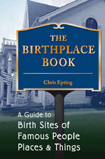
Buy The Birthplace Book at your local bookstore, or get it online here:
Amazon US
Amazon Canada
Amazon UK

Buy Led Zeppelin Crashed Here at your local bookstore, or get it online here:
Amazon US
Amazon Canada
Amazon UK
Kobo

